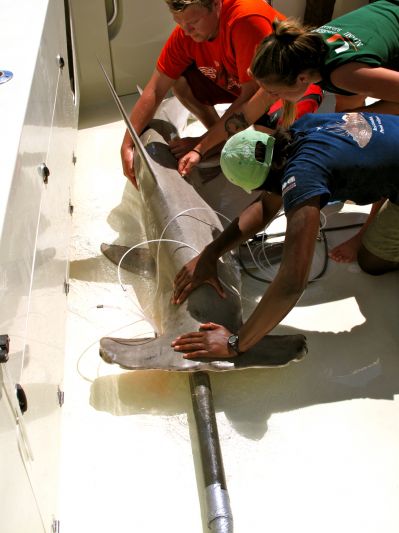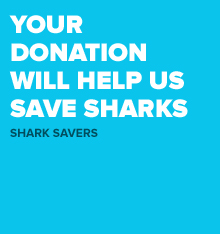Saturday May 5, 2012 may have been a typical Cinco de Mayo for many people; however, Shark Savers’ team members, Samantha Whitcraft and Jennah Caster, woke up at 5 a.m. to head down to the Florida Keys for a spectacular day of tagging sharks for research. We rendezvoused with the University of Miami’s R.J. Dunlap Marine Conservation Program (RJD) students and volunteers and the local Shark Whisperers charity at Curt-a-sea Charters in Islamorada.
It was an incredible day with calm seas and clear skies. The sharks kept us busy! By the end of the research trip, we collected data from six sharks. Under a federal and state approved research permit, the species caught, sampled, and released were:


We learned about some of the important methods employed by the tagging team to limit the stress to the sharks including keeping the time on the fishing line to a minimum, using circle hooks that are designed to catch only in the mouth, and using a tube of oxygenated water in the sharks’ mouths to keep them calm and ventilated.
Working quickly and efficiently to limit handling times, the trained students and volunteer assistants measured each animal and then collected a blood sample, tissue sample, and fin clip from each shark. All sharks were tagged with a uniquely numbered ‘spaghetti tag’ just under their dorsal fin – to identify them if they are re-captured in the study or caught by fishermen. Some of the bigger sharks, like the bulls where also fitted with satellite tags, attached to the side of the (first) dorsal fin.
According to the RJD Program webpage, the data are collected for research that will:
The resulting scientific publications produced from such research can help provide international conservation organizations like Shark Savers with additional and important tools to effectively advocate for policy changes to increase shark protections, expand or create new protected areas, and increase public awareness about the status of increasingly threatened shark populations and habitats worldwide. For example, as Austin Gallagher, a PhD student in the RJD program explains, “Some of my research seeks to understand how shark species react to the stress of fighting the fishing line; our results show that different species have different stress responses. Hammerheads, in particular, generally display a pronounced stress response. This information is important for informing future management for this species, and educating anglers...is also a key future step."
Being in the field and discussing these issues with young, dedicated field biologists reminded us that scientific research and its results can provide a vital tool for effective conservation and improved fisheries management. And it was great to be surrounded by so many enthusiastic shark supporters!
To learn more about the conservation status of these shark species and regulations currently in place to protect sharks in Florida, please visit:
http://myfwc.com/fishing/saltwater/regulations/sharks/
About the R.J. Dunlap Program’s scientific research:
The mission of the RJD is to foster Science, Technology, Engineering and Math literacy and advance marine conservation by conducting cutting edge scientific research involving graduate, undergraduate, high school students and the public through hands-on field and virtual learning experiences.
 Image Not Found.
Image Not Found.